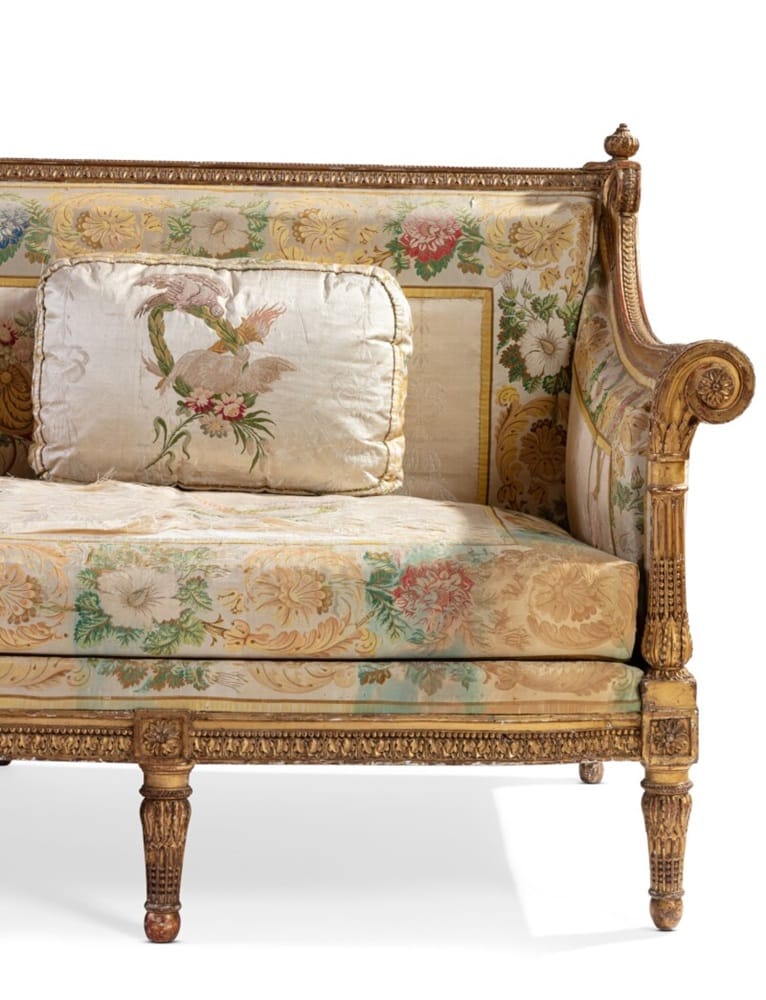Louis XVI Style: When France Triumphs over Antiquity
The Apex of French Neoclassicism • 1774-1792
The Louis XVI style revolutionizes Western art by consecrating the definitive return to Antiquity and the apex of French neoclassicism. This aesthetic revolution reflects the intellectual evolution of French society in the late 18th century: from Enlightenment erudition to antique art de vivre, from scholarly archaeology to neoclassical daily life. The French Louis XVI becomes the European reference style, copied from Saint Petersburg to Naples.
This aesthetic revolution, nourished by Academy teaching and travels to Italy, definitively transforms our conception of French elegance. The straight lines of Louis XVI impose a new ideal of beauty that still dominates Western decorative arts.
Louis XVI: The Creative Explosion of Triumphant Neoclassicism
The Revolution of Purity
This remarkable period, marked by eighteen years of neoclassical innovation, definitively transforms French and European art by imposing new standards of antique purity.
Decisive Chronology:
- • 1774-1792: Reign of Louis XVI (18 years)
- • 1775: Appointment of Marie-Antoinette – influence of Austrian taste
- • 1783: Treaty of Versailles – international influence of French style
This era overturns all codes of the declining Rococo decorative art. The artist-creator draws directly from Greek and Roman Antiquity, while the enlightened aristocracy becomes the prescriber of worldwide neoclassical taste.
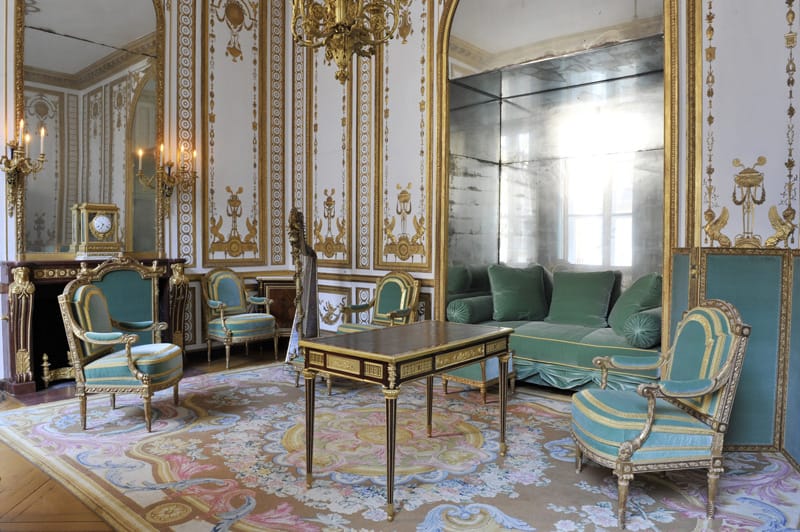
Georges Jacob, Jean-Henri Riesener, Pierre Gouthière embody this creative revolution that definitively transforms Western art.
The emergence of neoclassical society revolutionizes lifestyles. Archaeology, moral philosophy, cult of the Antique inspire an art that celebrates civic virtue and geometric harmony.
Revolution of Form and Order
The Alliance between Archaeological Science and French Excellence
It is now the neoclassical master cabinetmakers who invent modern aesthetics, definitively replacing Rococo curves with visionaries of pure antique geometry.
This era invents the revolutionary alliance between archaeological science and French excellence, antique erudition and Parisian refinement, democratizing scholarly art de vivre.
Louis XVI aesthetics abolishes the frontier between decorative and moral: pure straight lines, antique fluting, geometric garlands testify to virtuous modernity.

Arts: The Avant-garde of Antique Virtue
Paris and Europe, Laboratories of Neoclassicism
Paris and Europe, Laboratories of Neoclassicism
Parisian decorative art from 1775-1790 synthesizes all archaeological discoveries in a style of remarkable antique coherence.
Georges Jacob (master of neoclassical joinery), Jean-Henri Riesener (virtuoso of pure cabinetmaking), Adam Weisweiler (innovator of Greek forms) define this new aesthetic.
Richard Mique revolutionizes palatial architecture, Hubert Robert transforms decorative art through his ruins, while Jean-Jacques Bachelier explores the potentialities of antique porcelain.
The Renaissance of Neoclassical Arts and Crafts
Louis XVI style spectacularly revitalizes all French arts and crafts by nourishing them with pure antique references and orienting them toward geometric excellence.
Masters of Neoclassicism
- Georges Jacob: Virtuoso of fluted joinery
- Jean-Henri Riesener: Master of geometric marquetry
- Adam Weisweiler: Innovator of pure forms
- Pierre Gouthière: Master of bronzes of absolute antique purity
- Philippe Thomire: Creator of perfect ornamental language
Goldsmithery reaches new heights with Jacques-Nicolas Roettiers and Henry Auguste, while the Sèvres manufactory develops exceptional neoclassical decors.
Decorative sculpture revolutionizes itself with Jean-Antoine Houdon and Augustin Pajou who develop an antique language of perfect nobility.
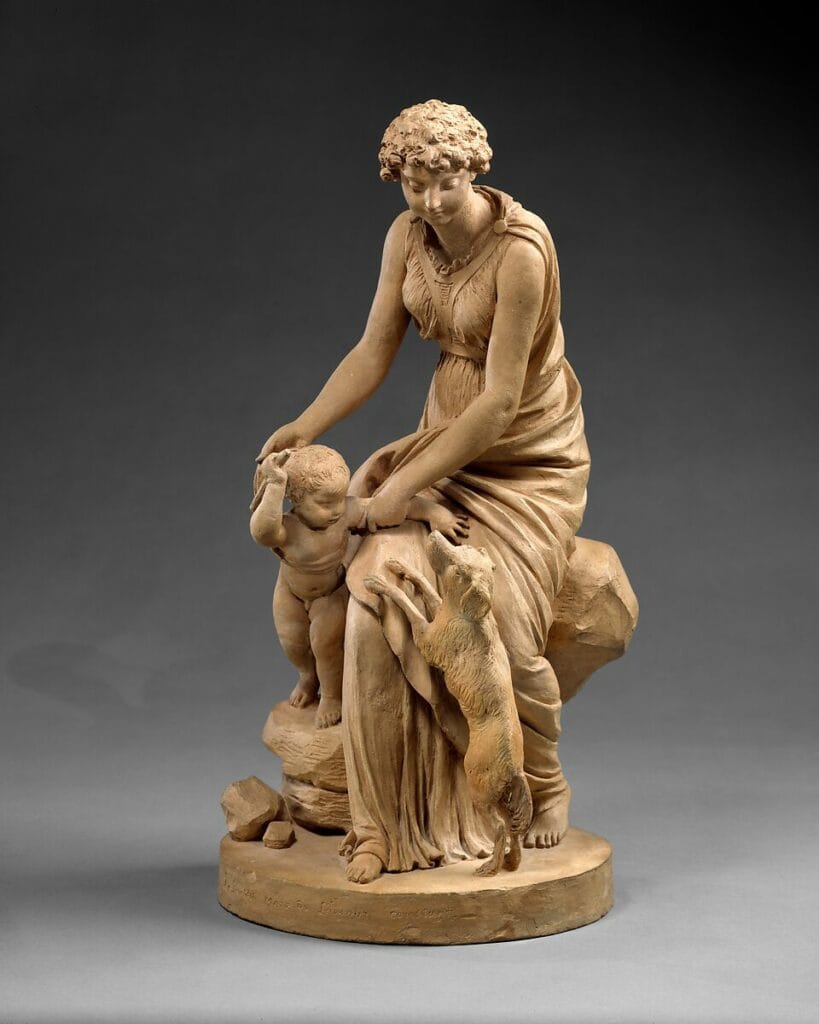
Louis XVI Architecture: Manifesto of Antique Purity
The Neoclassical Château as Innovation
The Neoclassical Château as Innovation: Laboratory of the Antique
This revolution imposes new architectural canons: pure orders, geometric pediments, revolutionary fluted columns.
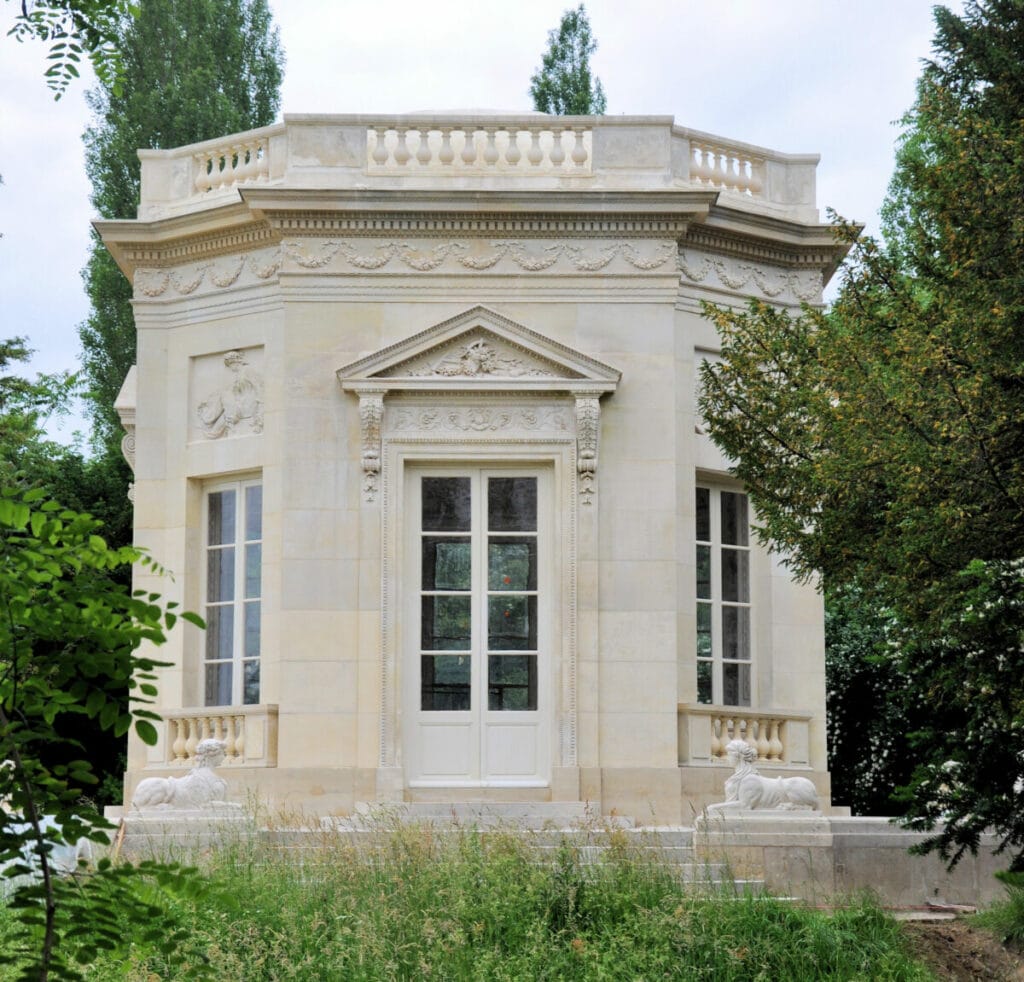
Permanent realizations (Bagatelle, renovated Petit Trianon, Hôtel de Salm) definitively inscribe neoclassical modernity in the French landscape.
This aesthetic revolution transforms France’s international image and influences European and American architecture.
Masters of French Architecture
Four master architects of neoclassicism embody this French avant-garde and the spirit of Louis XVI architecture. This architectural school, internationally celebrated, establishes the foundations of neoclassical art de vivre and inspires world capitals.
It revolutionizes our conception of pure habitat and durably imposes French geometry as universal aesthetic reference.
Claude Nicolas Ledoux
The architect Claude-Nicolas Ledoux, creator of radical neoclassical architecture, develops a revolutionary aesthetic that influences all modern architecture. Visionary architect of Louis XVI’s reign, Claude-Nicolas Ledoux (1736–1806) is one of the great representatives of French neoclassicism. He distinguishes himself through monumental architecture, with purified geometric forms and symbolic content, already announcing architectural utopia. We owe him notably the Royal Saltworks of Arc-et-Senans, a masterpiece inscribed on the world heritage list, as well as several private mansions and Parisian theaters. Theorist as much as builder, Ledoux marked his time through his ambition to unite function, aesthetics and social ideal, opening the way to architectural modernity that would influence the 19th century.
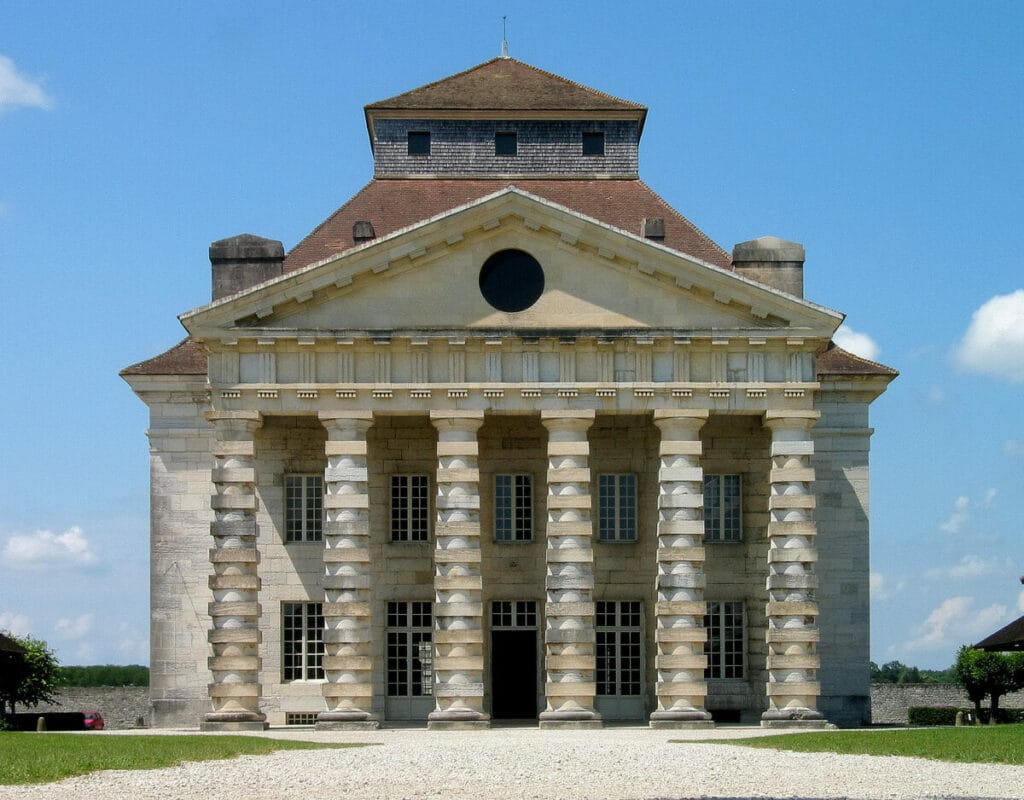
Etienne-Louis Boullée
Major theorist of neoclassical architecture, Étienne-Louis Boullée is famous for his visionary and monumental projects. He develops an aesthetic of pure geometry – spheres, cubes, pyramids – which he applies to imaginary edifices of gigantic scale, like the famous project of cenotaph for Newton, a sphere 150 meters in diameter. Although he built few buildings, his writings and drawings profoundly marked the history of architecture. Boullée embodies the Enlightenment utopia: an architecture both rational and sublime, destined to elevate the human spirit.
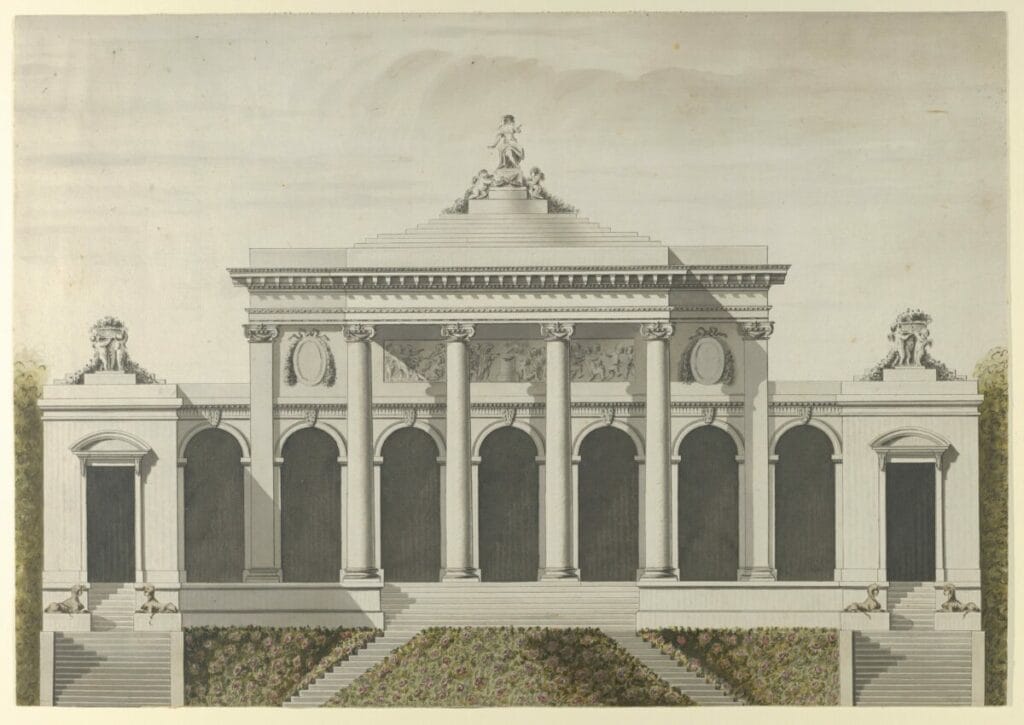
Richard Mique
Richard Mique (1728–1794) was Marie-Antoinette’s favorite architect and a refined representative of Louis XVI style. Trained in the classical tradition, he distinguishes himself through sober elegance and picturesque sensitivity. We owe him notably the Queen’s Hamlet and the rearrangement of Petit Trianon at Versailles, where he expresses a taste for idealized nature and rural intimacy. His realizations translate the spirit of the end of the Ancien Régime: a mixture of neoclassical rigor and bucolic fantasy, in service of a queen seeking refuge and freedom.

Alexandre-Théodore Brongniart
Alexandre-Théodore Brongniart (1739–1813) is one of the great masters of French neoclassicism, known for his rational, symmetrical architecture inspired by Antiquity. His style, both sober and monumental, seeks to translate the ideals of the Enlightenment by reconciling beauty, utility and geometric clarity. We owe him several major works that have durably marked Paris: the Palais Brongniart (Paris Stock Exchange), secular temple of finance imagined as an edifice of authority and stability; Père-Lachaise cemetery, the first great modern landscape cemetery in France, conceived as a memorial promenade; but also private mansions such as Hôtel de Masseran. Through his realizations, Brongniart contributed to making architecture a political and civic language, emblematic of the transition between the Ancien Régime, Revolution and Empire.
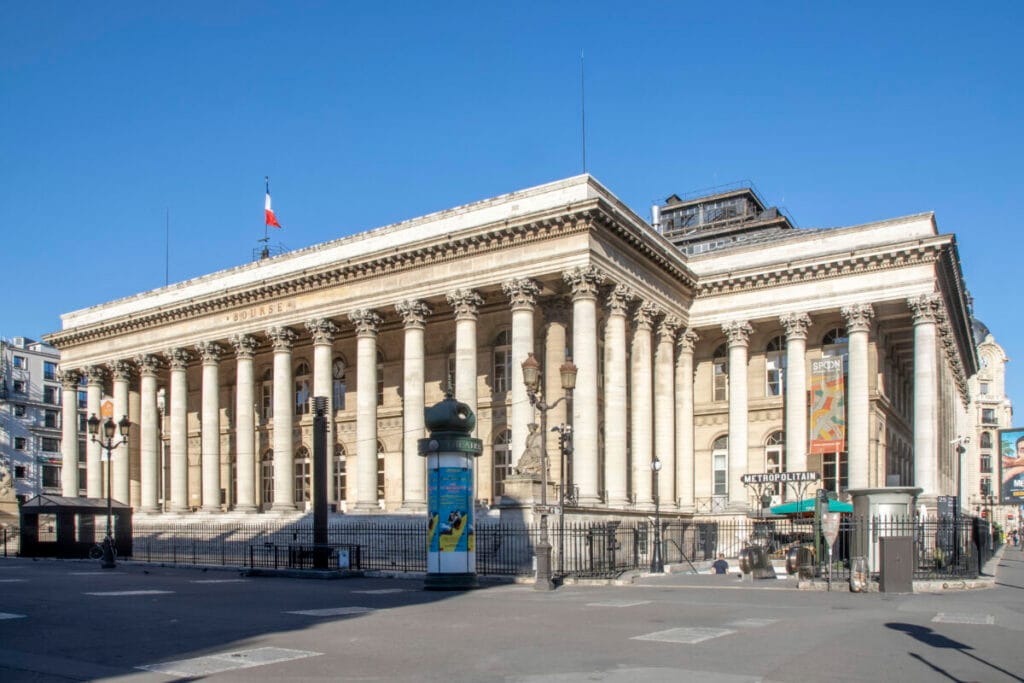
Total Decorative Art
The Synthesis of Arts in Service of Pure Beauty
Louis XVI style invents the concept of antique art de vivre where architecture, furniture, art objects and textiles form a harmonious ensemble in service of pure beauty.
The creators Georges Jacob, Jean-Henri Riesener, Pierre Gouthière develop the art of antique decorative synthesis.
The Synthesis of Arts
Louis XVI style codifies a universal decorative vocabulary that triumphs in Europe: pure geometries, antique motifs, classical orders.
Élisabeth Vigée Le Brun (neoclassical portraitist), Hubert Robert (painter of ruins) revolutionize applied arts through their antique innovations.
The influence of triumphant archaeology and French tradition introduces a pure classicism that dominates European inspiration.
The arts of furnishing reach their apex with bronze workers Gouthière and Thomire, the cabinetmakers of faubourg Saint-Antoine, creators of objects of antique refinement.
Porcelain finds its definitive expression with neoclassical creations from Sèvres which develop a table art of Greek purity.
The workshops of Jean-Henri Riesener (perfect cabinetmaking), Pierre Gouthière (furniture bronzes), Philippe Thomire (exceptional gilding) establish new world standards.
Riesener’s furnishing, Gouthière’s bronzes, geometric silks create an art de vivre of antique sophistication.
Characteristics of Louis XVI Decorative Art
- Absolute geometry: Straight lines and perfect proportions
- Noble materials: Mahogany, gilded bronzes, precious marbles
- Pure functionality: Beauty and use reconciled
The apartments of Marie-Antoinette, decorated in Greek taste, perfectly embody this decorative revolution where French art meets daily pure Antiquity.
Fabrics of Louis XVI Style: The Art of Neoclassical Textiles
Materials and Textures: The Revolution of Purity
Materials and Textures: The Revolution of Purity
Louis XVI style revolutionizes textile art by privileging purity of materials and decorative geometry. French manufactories develop perfected techniques that transform textiles into structured and noble decorative elements.
Louis XVI Textile Innovations
- Neoclassical Lyon silks: Geometric figured patterns and architectural effects
- Geometric damasks: Perfect symmetrical motifs inspired by antique architecture
- Plain taffetas: Beauty of pure material over ornamentation
- Embroidered muslins: Revolutionary simplicity and new freshness
Color Palette: The Invention of Antique Colors
The Louis XVI colorist revolution creates a neoclassical palette that imposes new chromatic references inspired by Antiquity.
Signature colors:
- Sèvres Blue: Deep blue created at the manufactory, world reference for royal blue
- Etruscan Red: Matte red inspired by Greek vases, revolution of French palette
- Antique Green: Dark green reference to oxidized bronzes, new French sobriety
- Matte Gold: Powdered architectural gilding, abandoning Rococo brilliance
Motifs and Iconography: The Triumphant Antique Vocabulary
Louis XVI textile ornamentation develops an iconographic repertoire directly inspired by Greek and Roman Antiquity.
Antique motifs:
- Greek palmettes: Geometric palmettes in their absolute antique purity
- Meanders: Greek geometric friezes dominating neoclassical ornamentation
- Acanthus leaves: Stylized plant motifs according to antique models
- Lyres and instruments: References to antique music and liberal arts
Scholarly iconography:
- Allegories of Virtues: Moralizing representations inspired by Antiquity
- Military trophies: Helmets, lictor’s fasces, stylized armor
- Pastoral scenes: Rural idylls in the spirit of revisited Watteau
- Attributes of Arts: Musical instruments, artisan tools, books and scrolls
Techniques and Manufactories: French Excellence
French manufactories revolutionize textile techniques to meet the aesthetic requirements of Louis XVI style. Lyon becomes the European capital of neoclassical silk.
Major technical innovations:
- Perfected looms: Allowing complex geometries
- Chemical dyes: Revolutionary stability and intensity of colors
- Copper printing: Precision of motifs, fineness of details
- Figured weaving: Relief effects and sophisticated material play
Louis XVI Furniture: Excellence of French Cabinetmaking
Pure Geometry and Noble Functionality
Master Cabinetmakers: Revolutionaries of Form
Louis XVI cabinetmaking reaches heights of technical and aesthetic excellence. Parisian masters develop a revolutionary formal language that still influences contemporary furniture art.
Georges Jacob (1739-1814): The Genius of Joinery
- Major innovation: Definitive abandonment of Rococo curves for pure geometry
- Revolutionary technique: Perfect fluting, invisible assemblies
- Emblematic creations: Seats for Marie-Antoinette, revolutionary furniture
- Heritage: Founds a dynasty of cabinetmakers dominating the 19th century
Jean-Henri Riesener (1734-1806): Master of Marquetry
- Unique specialty: Geometric marquetry of absolute precision
- Noble materials: Mahogany, ebony, mercury-gilded bronzes
- Royal clientele: Official cabinetmaker to Marie-Antoinette
- Signature style: Sober elegance, perfect functionality
Furniture Typology: Innovation and Tradition
Louis XVI furniture develops a revolutionary functional typology that responds to new social uses while expressing the ideal of antique beauty.
Seats and Armchairs: The Art of Noble Seating
- Fluted bergères: Straight backs, full armrests, maximum comfort
- Fauteuils à la Reine: Flat rectangular backs, tapered legs
- Medallion chairs: Circular backs, major aesthetic revolution
- Marquises: Wide seats for two people, aristocratic sociability
Storage Furniture: Functionality and Beauty
- Straight commodes: Abandonment of curves, drawers without visible traverse
- Drop-front secretaries: Perfected mechanisms, secret compartments
- Glass-front bookcases: Protection and showcasing of books
- Monumental armoires: Miniature architecture, classical pediments
Techniques and Materials: Artisanal Excellence
Louis XVI cabinetmaking revolutionizes manufacturing techniques and introduces new materials that transform furniture aesthetics.
Major technical innovations:
- Perfected assemblies: Tenons and mortises of absolute precision
- Geometric marquetry: Veneers in sheets of precious essences
- Furniture bronzes: Chasing and mercury gilding, exceptional durability
- Pad varnishing: Perfect brilliant finishes, lasting protection
The Eternal Heritage of Louis XVI Style
Worldwide Influence and Contemporary Renaissance
International Influence: Neoclassical Europe
Louis XVI style becomes the reference aesthetic language of European aristocracy. Its diffusion definitively transforms Western decorative art and establishes France as arbiter of international taste.
Influence by country:
- England: Adam and Sheraton styles directly inspired, Hepplewhite furniture
- Russia: Catherine II’s palaces, massive orders to Parisian cabinetmakers
- Austria: Influence via Marie-Antoinette, Schönbrunn castle renovated
- United States: Federal Style, Jefferson’s architecture inspired by French neoclassicism
Survivals and Renaissances: From 19th to 21st Century
Louis XVI aesthetics crosses centuries by adapting to social and technical evolutions. Each era rediscovers its virtues: geometric purity, artisanal excellence, noble functionality.
Successive renaissances:
- Empire (1804-1815): Systematization and amplification of neoclassical codes
- Louis-Philippe style: Bourgeois adaptation, democratization of forms
- Neo-Louis XVI (1880-1900): Exact revival, nostalgia for Ancien Régime
- Contemporary art: Minimalism, Scandinavian design, modern architecture
Influence on Contemporary Design
Contemporary creators constantly draw from Louis XVI heritage: pure geometry, noble materials, elegant functionality correspond to current aspirations of sustainability and authenticity.
Louis XVI Style: Apotheosis of French Decorative Art
The Immortal Heritage of Triumphant Neoclassicism
Louis XVI style embodies the apotheosis of French decorative art and the perfect synthesis between artisanal excellence and intellectual vision. This aesthetic revolution, born from the encounter between Enlightenment erudition and French creative genius, definitively transforms our conception of beauty and establishes the foundations of modern aesthetics.
More than a simple historical style, Louis XVI reveals the unique capacity of French art to transmute influences into original creation. Greek and Roman Antiquity becomes source of inspiration for a resolutely modern art, archaeological science nourishes a living aesthetic, technical excellence serves a poetic vision of daily life.
The heritage of Louis XVI style far exceeds its chronological limits. Its fundamental principles – pure geometry, noble functionality, authentic materials, artisanal excellence – continue to inspire contemporary creators seeking an alternative to industrial standardization. In a changing world, Louis XVI offers a timeless model of conscious beauty and refined art de vivre.
Today still, from Versailles to contemporary workshops, from European palaces to modern interiors, Louis XVI style testifies to the permanence of French creative genius and its capacity to shape world aesthetics. It remains the most accomplished expression of French art de vivre and the eternal symbol of the successful alliance between tradition and innovation, beauty and function, excellence and elegance.
Resources
Design Fundamentals
History of Design & Decorative Styles
From baroque salons to the radical lines of the 20th century, this chronological timeline highlights the aesthetic revolutions that have marked our daily environment.
Read the page “History of Design & Decorative Styles”Hart Design Glossary from A to Z
Sabre legs, patina, passementerie, caning… This lexicon gives meaning to the technical and stylistic terms often used in the design world.
Access the Hart Design GlossaryHart Glossary of Design Icons
This glossary lists all the great names in design and decoration in alphabetical order. Discover the creators who have shaped contemporary living art.
Access the Hart Glossary of Design Icons
Digital entrepreneur and craft artisan, I use my unconventional background to share my vision of luxury design and interior decoration — one enriched by craftsmanship, history, and contemporary creation. Since 2012, I have been working daily in my workshop on the shores of Lake Annecy, creating bespoke interiors for discerning decorators and private clients.

